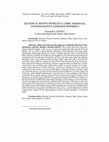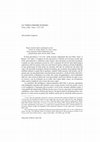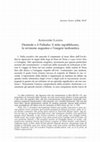Papers by Alessandro Lagioia
Classica et Christiana, 2023
de las revueltas bagaudas desde el siglo III hasta el siglo XVIII [Historiography of the bagaudic... more de las revueltas bagaudas desde el siglo III hasta el siglo XVIII [Historiography of the bagaudic revolts from the 3 rd century to the 18 th century] / 437 Enrico SIMONETTI, Metamorfosi 'in embrione'. L'epillio di Io nell'Eroide di Ipermestra (14,85-108) ['Embryonic' Metamorphosis: Io-Epyllion in Hypermestra's Epistle (Ovid Heroides XIV 85-108)] / 491 Nelu ZUGRAVU, Metafore ale ciumei în surse latine târzii [Metaphors of the plague in late Latine sources] / 509
Il peso della cultura: 'palliati' e 'suffarcinati' da Plauto ad Agostino, pp. 77-96
Invigilata Lucernis 44, 2022
This study focuses on the passage from Plautus’ Curculio (vv. 288-295) in which the parasite mock... more This study focuses on the passage from Plautus’ Curculio (vv. 288-295) in which the parasite mocks the Greeks wearing the pallium. In the light of the previous bibliography, my textual analysis aims at drawing attention to the interpretation of palliatus, capite operto, suffarcinatus, sportula. The reception of the scene is then examined, through the references to the typical dress of philosophers and the presence of the word suffarcinati in other authors. It is mainly an archaic word of comedy, which has few occurrences after Plautus and Terence. Suffarcinati was probably taken up by Jerome, a passionate reader of Plautus’ plays, and thanks to him the verb was brought back to use in Late Antiquity, by Paulinus of Nola and Augustine.
Totis ingenii gressibus insequor (Petrarca, Fam. XXIV 10, 136): nei margini e sulle orme di Orazio, pp. 121-154
C. Longobardi (a cura di), HORATIANA La ricezione di Orazio dall'antichità al mondo moderno: le forme liriche, ETS, Milano, 2022

Classica et Christiana
When the chin got the papyrus roll dirty: Martial, Winckelmann and the Modern Interpretation. The... more When the chin got the papyrus roll dirty: Martial, Winckelmann and the Modern Interpretation. The article examines some passages of Martial (epigr. 1, 66; 10, 93; 14, 84) and a pederastic epigram by Strato of Sardis (AP 12, 208), to which Perotti, Salmasius, Winckelmann and many other philologists frequently referred in order to explain why the chin is mentioned by those authors in relation with the use of the papyrus roll. The most frequently given explanation for the chin that dirties the roll has so far been that, after the volumen had been read, it was placed by the ancient reader under the chin to hold it firm and then it was rolled up, taking the tips of the roll in both hands. This reconstruction, apart from being unconvincing, because unpracticable, as Skeat has well demonstrated, does not find any confirmation, neither in poetic contexts nor in figurative representations. On the contrary, well known Pompeian frescoes seem to confirm that the ancients used to put the edging of the liber (frons), already rolled up, under the chin as a gesture of concentration and meditation. It can be compared to the pose of the thinker (philosopher, poet and actor), who meditates with a hand under the chin, a fairly common posture in the ancient iconographic tradition. The Pompeian portraits suggest that the only useful involvement of the chin relating to the ancient book could be that of levelling the edges of the volumen, once it has been closed and tightened with the help of both hands. Martial's references to the chin can therefore be traced back to a similar gesture, from which we can infer that only the frontes of the roll could got dirty and crumpled more easily by a prickly beard, while both Strato's epigram and Martial's ones carry a sexual allusiveness which suggests due caution in the interpretation of their content strictly in a technical sense.
Type de publication: Collectif Directeurs d'ouvrage: Baker (Craig), Cavagna (Mattia), Guadagnini ... more Type de publication: Collectif Directeurs d'ouvrage: Baker (Craig), Cavagna (Mattia), Guadagnini (Elisa) Responsable éditorial: Trachsler (Richard) Directrice d'ouvrage adjointe: Otzenberger (Pauline) Résumé: Les contributions à ce volume explorent la réception médiévale d'Ovide dans les domaines latin, catalan, français et italien. Elles invitent à nuancer l'opposition entre latin et vernaculaire au profit d'une vision plus complexe des rapports entre texte, traduction et glose.
Il Risus di Canio Rufo e il Lusus di Marziale (3.20)
Lexis, 2020
The contribution traces a profile of the character of Canius Rufus, Martial’s friend and a poet h... more The contribution traces a profile of the character of Canius Rufus, Martial’s friend and a poet himself, according to the information contained in several epigrams. Moreover, it proposes a re-interpretation of epigr. 3.20 as an elegant literary lusus, written by Martial on the basis of three literary hypotexts (Hor. epist. 1.3 and 8 and Catull. 55). This character of the composition makes it possible to assign a different meaning to Canius Rufuse’s laughter at its end.

Maia Rivista Di Letterature Classiche, 2014
Erige crinales lauros seniumque sacrati verticis in virides, Roma, recinge comas. Aurea turrigero... more Erige crinales lauros seniumque sacrati verticis in virides, Roma, recinge comas. Aurea turrigero radient diademata cono perpetuosque ignes aureus umbo vomat. Il tema dei distici (I 115-118) 1 , nella sezione culminante del così detto "inno" a Roma (I 45-166), è l'augurio di una miracolosa e florida reviviscenza rivolto alla Città, personificata e celebrata come regina e dea dal poeta in procinto di partire, il quale era stato nominato praefectus urbi a distanza di soli tre anni dalla tragica esperienza dell'invasione e del sacco dei Goti di Alarico. Roma è ritratta da Rutilio, in una professione di fede nella sua eternità, nell'atto di risollevare gli allori del capo e di rinverdire la propria chioma incanutita, per assumere nuovamente tutti gli attributi militari e regali che le spettano, simboli 2 della maestà e del trionfo, che figurano qui con una particolare concentrazione esornativa, anche di tratti coloristici: la corona turrita, il diadema e lo scudo, che vanno ad aggiungersi, con lo splendore dell'oro, alla corona d'alloro dei versi precedenti, anch'essa riferita al capo (crinales lauros), con un richiamo sia al verde, che è pure delle comae, sia al biancore della canizie (implicito nel senium del sacro capo). La metafora del prodigioso ringiovanimento dell'Urbe è giocata soprattutto sull'ambiguità semantica del termine comae (come frondes lauri ma anche crines) e nel complesso l'immagine più evocativa, al di là dei consueti attributi regali, è certo quella del mutamento di Roma da una cana senectus, per usare un'espressione catulliana, a una verde e rifiorita giovinezza. Su questa linea d'interpretazione complessiva si sono mossi in genere gli studiosi anche per la soluzione della quaestio 1 I versi sono qui riprodotti secondo la versione concorde delle edizioni di Wolff, Fo, Castorina e Vessereau, che accettano la lezione recinge tràdita dal consensus dei codici del De reditu.
L'"eventus" di Gargano, eroe eponimo della Montagna dell'Angelo
Invigilata Lucernis, 2012
The article examines the initial section of the so-called «narrative of Garganus and the bull» in... more The article examines the initial section of the so-called «narrative of Garganus and the bull» in the hagiographical text De Apparitione sancti Michaelis in Monte gargano, probably belonging to the second half of the eighth century. It suggests the interpretation of the term eventus in the usual sense of event, rather than adventus, in the light of both lexical occurrences of the term in similar contexts and the hagiographical account, which, of the word garganus, aims to spread a new etymology more suited to the new religious climate.
Nota esegetica a Lycophr. Alex. 1265-1266
Invigilata Lucernis, 2007

This article originates in the analysis of the praefatio to Servius’ commentary on Vergil’s Aenei... more This article originates in the analysis of the praefatio to Servius’ commentary on Vergil’s Aeneid 3, in which an unexpected depiction of Aeneas as being territus adventu Diomedis appears, otherwise missing in Vergil’s work. The investigation aims at a definition of Diomedes’ role both in the antiquarian republican tradition (which Servius and Servius Danielis refer to) and in the Augustan Age. The study focuses especially on the hypothesis of a Varronian source for S and SD, and even for Vergil himself, as deducible from the analysis of the syntagm hostilis facies (Aen. 3, 407). As for the Augustus’era a sort of censure against Diomedes, the carrier of the Palladium to Italy, can be inferred from the Augustan poets’ silence about Diomedes, the study of Dionysus of Halicarnassus’ data and iconographic evidence. An anonymous Vergilian scholium is then examined with reference to traces of a lost poem, the Diomedea, composed by Iullus Antonius under Augustus (the anti-Aeneid?)
The essay sets out to examine the history and content of a few folios (69r-73v) collected in the ... more The essay sets out to examine the history and content of a few folios (69r-73v) collected in the miscellaneous Vatican Codex Reg. Lat. 1625. The ninth century parchment section, probably from St Benoît-sur-Loire, transmits an abridged and fragmentary version of the Virgilian Commentary of Servius auctus ad Aen. V-VI. Although the text was already known to Pierre Daniel, it has been so far neglected by the editors of Servius’s Commentaries. In this study it is examined in its relationship with others of Daniel’s witnesses and it can potentially prove useful for the constitutio textus. The commentary of the Reg. is enriched with further exegetic material to be found in the body itself of the commentary, as well as in the margins and spacings of the text. Among these sources there are: Tiberius Claudius Donatus, the so-called Glossarium Ansileubi and the First Vatican Mythographer.
La Memoria agiografica di san Michele sul Gargano. Testo critico, traduzione e commento a cura di Alessandro Lagioia. Prefazione di Giorgio Otranto
Commento all'«Oedipus» di Seneca
Plaut. Pseud. 164: tempo di pulizie
The article examines the reading coctaque (Pseud. 164) in the Palatine MSS., which is certainly c... more The article examines the reading coctaque (Pseud. 164) in the Palatine MSS., which is certainly corrupted, and the conjecture structaque; it then goes on to investigate the indirect tradition, represented by a quotation from Servius Auctus, Commentary on Aen. 1, 478: the scholium contains the reading unctaque, supported also by a passage from Cicero’s Paradoxa. Related to the context the reading unctaque might be right, and ‘ungere’ might be used with the rare meaning of ‘to polish silver’.
A. Lagioia, Dal Gargano all'Elicona: la Memoria di san Michele fra agiografia ed elegia
Una versione greca inedita della Apparitio sancti Michaelis in monte Gargano (BHG 1288h, Messan. gr. 29)
Prospettive sidoniane. Convegno internazionale: Bari, Università degli Studi Aldo Moro, 20 novembre 2017
I prologhi del Terzo Mitografo Vaticano
“Sensitive Topics” in the Medieval School - Censorship and Interpretation in Ovid’s Metamorphoses and the Commentary of the Vaticanus Latinus 1479











Uploads
Papers by Alessandro Lagioia